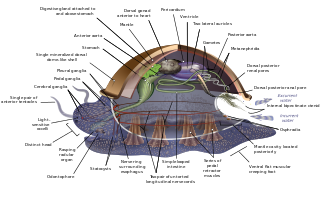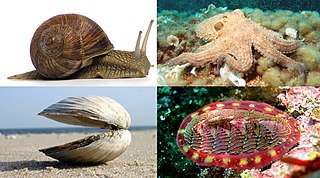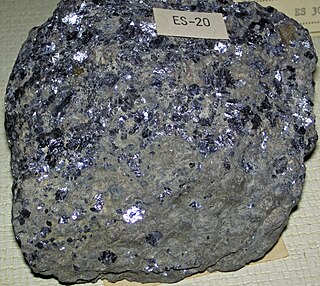
Nectocaris pteryx is a species of possible cephalopod known from the "early Cambrian" Emu Bay Shale and Chengjiang biota, the "middle Cambrian" Burgess Shale.

Monoplacophora, meaning "bearing one plate", is a polyphyletic superclass of molluscs with a cap-like shell now living at the bottom of the deep sea. Extant representatives were not recognized as such until 1952; previously they were known only from the fossil record, and were thought to have become extinct 375 million years ago.

The evolution of the molluscs is the way in which the Mollusca, one of the largest groups of invertebrate animals, evolved. This phylum includes gastropods, bivalves, scaphopods, cephalopods, and several other groups. The fossil record of mollusks is relatively complete, and they are well represented in most fossil-bearing marine strata. Very early organisms which have dubiously been compared to molluscs include Kimberella and Odontogriphus.

Yochelcionella is an extinct genus of basal molluscs which lived during the Tommotian epoch, the first epoch of the Cambrian period. This genus is often reconstructed to resemble snails.

Plectronocerida is a primitive order from which subsequent cephalopod orders are ultimately derived.
The Ellesmerocerida is an order of primitive cephalopods belonging to the subclass Nautiloidea with a widespread distribution that lived during the Late Cambrian and Ordovician.

Helcionellid or Helcionelliformes is an order of small fossil shells that are universally interpreted as molluscs, though no sources spell out why this taxonomic interpretation is preferred. These animals are first found about 540 to 530 million years ago in the late Nemakit-Daldynian age, which is the earliest part of the Cambrian period. A single species persisted to the Early Ordovician. These fossils are component of the small shelly fossils (SSF) assemblages.

Mollusca is the second-largest phylum of invertebrate animals after the Arthropoda, the members of which are known as molluscs or mollusks. Around 85,000 extant species of molluscs are recognized. The number of fossil species is estimated between 60,000 and 100,000 additional species. The proportion of undescribed species is very high. Many taxa remain poorly studied.

Knightoconus antarcticus is an extinct species of fossil monoplacophoran from the Cambrian Minaret Formation of Antarctica. It is thought to represent an ancestor to the cephalopods. It had a chambered conical shell, but lacked a siphuncle.

Volborthella is an animal of uncertain classification, whose fossils pre-date 530 million years ago. It has been considered for a period a cephalopod. However discoveries of more detailed fossils showed that Volborthella’s small, conical shell was not secreted but built from grains of the mineral silicon dioxide (silica), and that it was not divided into a series of compartments by septa as those of fossil shelled cephalopods and the living Nautilus are. This illusion was a result of the laminated texture of the organisms' tests. Therefore, Volborthella’s classification is now uncertain. It has been speculated that it may in fact represent a sclerite of a larger organism, on the basis of one specimen; however, it may be premature to accept this hypothesis, as the arrangement of sclerites producing this impression may have occurred by chance. The Ordovician scleritome-bearing Curviconophorus, as well as the Halwaxiids, lobopods and echinoderms, demonstrate the diversity of organisms which may produce a scleritome of this nature. The related Campitius was originally suggested to be part of a radula rather than a scleritome, but is now considered a synonym of Volborthella.

Bellerophontoidea, common name "bellerophonts", is a superfamily of extinct planospirally-coiled globose molluscs. This superfamily is generally included within the Gastropoda, but may instead be a group of monoplacophorans. The taxon first appeared late in the Cambrian and continued until late in the Triassic.
Robustum nodum is the one species of a problematic genus of Ordovician hemithecellid mollusc proposed by Stinchcomb and Darrough in 1995. Its similarities to Matthevia were outlined by Vendrasco & Runnegar.
Hemithecella is a problematic genus of Ordovician mollusc proposed by Stinchcomb and Darrough in 1995. Hemithecella belongs to what are informally known as multiplated molluscs; it is found in the late Cambrian of the Ozarks and the Lower Ordovician of the same region as well as in Minnesota and the southern Appalachian Mountains. Hemithecella has muscle scars identical to a monoplacophoran and not the musculature of a chiton to which some authors have suggested the multiplated molluscs belong. It is therefore classified in the Mattheviidae.
Stenothecidae is an extinct family of fossil univalved Cambrian molluscs which may be either gastropods or monoplacophorans.
The Kirengellids are a group of problematic Cambrian fossil shells of marine organisms. The shells bear a number of paired muscle scars on the inner surface of the valve.
The cephalopods have a long geological history, with the first nautiloids found in late Cambrian strata, and purported stem-group representatives present in the earliest Cambrian lagerstätten.
Vologdinella is a poorly known genus of extinct animals of uncertain classification with small cylindrical shells. The animals are known from Middle Cambrian fossils from a Paleozoic limestone in the Chingiz Mountains of Kazakhstan. The genus was established by Russian paleontologist Zakhar Grigoryevich Balashov in 1962 for a single species, Vologdinella antiqua, which was originally described and illustrated as Orthoceras? antiquus by Aleksandr Grigoryevich Vologdin in 1931.
Tuarangia is a Cambrian shelly fossil interpreted as an early bivalve, though alternative classifications have been proposed and its systematic position remains controversial. It is the only genus in the extinct family Tuarangiidae and order Tuarangiida. The genus is known solely from Middle to Late Cambrian fossils found in Europe and New Zealand. The genus currently contains two accepted species, Tuarangia gravgaerdensis and the type species Tuarangia paparua.

The Bonneterre Formation is an Upper Cambrian geologic formation which outcrops in the St. Francois Mountains of the Missouri Ozarks. The Bonneterre is a major host rock for the lead ores of the Missouri Lead Belt.
Dorothy Jung Echols was an American Geologist. She was a Professor for the Department of Earth and Planetary Sciences at Washington University in St. Louis.








